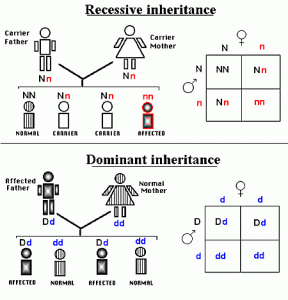Characteristics of Autosomal Recessive/Dominant Traits
When it comes to dominant genes on an autosome (any chromosome other than a sex chromosome), the alleles and their associated traits are either autosomal dominant or autosomal recessive. They are both examples of ways that a trait or disorder can be passed down (inherited) through families. A mutation in a gene on one of the first 22 nonsex chromosomes can lead to an autosomal disorder. Some mutations are caused by lethal alleles, which cause the death of an organism when they’re expressed. If the allele is dominant, then both the heterozygous and homozygous dominant individuals will die. If it is recessive, then the heterozygous individuals will live, but the homozygous recessive individuals will die.
In an autosomal dominant disease, if you inherit the abnormal gene from only one parent, you can get the disease– it dominates. The parent might even have the disease themselves. Surprisingly, an autosomal dominant disease can also occur as a new condition in a child when neither parent has the abnormal gene. Parents that have an autosomal dominant condition have a 50% chance of having a child with the condition for every pregnancy. The health of the child’s sibling(s) doesn’t affect the health of the child. If the child doesn’t develop the abnormal gene, they never will and they do not have to fear passing it on to their children. Therefore, an infected parent doesn’t necessarily mean an infected child, but an infected child always means the parent is infected (with the exception of a new mutation and reduced penetrance). In autosomal dominant inheritance, each generation should have affected individuals and males and females are equally likely to be affected.
An autosomal recessive disorder means two copies of an abnormal gene must be present in order for the disease or trait to develop. Genes come in pairs: one from the mother and one from the father. To cause disease with recessive inheritance, both genes in a pair must be abnormal. People with only one defective gene in the pair are called carriers. Carriers are usually not clinically affected by the disease, but they are capable of passing it on. If both parents carry the same autosomal recessive mutation, there is a 50% chance that their child will inherit one abnormal gene (making them a carrier), a 25% chance that they will inherit neither, and a 25% chance that they will inherit both (making them infected). Because of that 25% chance, this disease is common among siblings. Males and females are equally likely to be affected by autosomal recessive inheritance. Unlike dominant inheritance, it’s common that affected individuals have unaffected parents.
